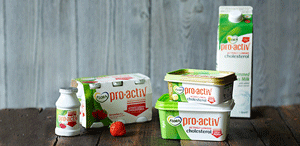 Given the tendency for over-indulgence during the Festive Season it’s not surprising that some brand owners of diet plans, slimming and low fat products will think their Christmases have all come at once in the New Year as millions of us try to shake off the excesses of eating and drinking by trying to lose some weight!
Given the tendency for over-indulgence during the Festive Season it’s not surprising that some brand owners of diet plans, slimming and low fat products will think their Christmases have all come at once in the New Year as millions of us try to shake off the excesses of eating and drinking by trying to lose some weight!
Marketers may be tempted to do what Flora pro. activ (owned by Unilever) did a few years’ ago in the UK by inviting a national journalist to ‘fight the flab’ and exercise alongside a calorie controlled diet and keep a daily record of her progress.
This may sound like a great way to connect with consumers who may feel they need some encouragement to do the same.
 Except that Unilever didn’t make it absolutely clear that what was being presented by Chris Jones was in fact paid for advertorial, or what’s commonly known as native advertising, as it was disguised to look like editorial content on the Telegraph web site.
Except that Unilever didn’t make it absolutely clear that what was being presented by Chris Jones was in fact paid for advertorial, or what’s commonly known as native advertising, as it was disguised to look like editorial content on the Telegraph web site.
Which of course begs the question why can’t an opinion of a journalist be independent even if a brand pays for the privilege?
A statement near the feature that said “in association with Flora pro.activ’ as well as a footer that clearly stated “If you’d like to read more inspiring stories and useful information about how Flora pro.activ can help lower your cholesterol, visit floraproactiv.co.uk” wasn’t enough to satisfy the rules that regulate this form of marketing and the Advertising Standards Authority (ASA) ruled the ad misleading.
It explained: “We noted that the advertorial was written in the style of a health and lifestyle piece and we considered that the overall impression of the ad was that it was an article written independently by a Telegraph journalist. We noted that the title, sub-title and text at the end of ad referred to Flora pro-activ, but considered that those references were not sufficient to counter the overall impression created by the advertorial, or mean that it was clearly identifiable as a marketing communication.”
 Earlier this month, other native advertising practices such as marketing communications appearing within feeds alongside updates from friends and followers on social media were put under the microscope by the Federal Trade Commission in a workshop “Blurred Lines: Advertising or Content” held in Washington DC.
Earlier this month, other native advertising practices such as marketing communications appearing within feeds alongside updates from friends and followers on social media were put under the microscope by the Federal Trade Commission in a workshop “Blurred Lines: Advertising or Content” held in Washington DC.
Proponents of native advertising are keen to point out that such ads only work if they are of sufficient quality to merit the consumer’s attention. The issue with native ads is that it’s hard to reconcile the idea of content which matches the form and function of its environment with the principle that ads must be obviously identifiable as such – and that advertorials must be signposted.
In the US and UK, serving content to consumers in new ways isn’t a problem per se, as I discussed in my latest book, Essential Law for Marketers, even when this is paid for by a brand owner like Unilever and doesn’t look out of place within the rest of the online media’s offering or what’s considered ‘contextually targeted branded content’.
The important point for marketers to consider is that it needs to be obvious to the consumer that they’re viewing an ad. And this judgment call may not be as easy or straight forward at first glance.
 In the UK, the ASA is yet to rule on ads served by content aggregators and what type of signpost is appropriate. But judging by the mood on both sides of the Atlantic, it’s likely that such marketing communications will be deemed unlawful if the link to the product or service suggests it’s been selected on merit rather than on a paid-for basis.
In the UK, the ASA is yet to rule on ads served by content aggregators and what type of signpost is appropriate. But judging by the mood on both sides of the Atlantic, it’s likely that such marketing communications will be deemed unlawful if the link to the product or service suggests it’s been selected on merit rather than on a paid-for basis.
Under the CAP Code, such marketing communications will be seen to be native advertising and potentially not permitted if it’s seen as “an advertisement feature, announcement or promotion, the content of which is controlled by the marketer, not the publisher, that is disseminated in exchange for payment or other reciprocal arrangement.”
The solution is to package the message in a way that a journalist will see the merits in an editorial context and let them make up their own mind.
Of course this takes skill, creative thinking and a lot of experience.
It’s called PR.














Recent Comments